Celebrating 700 Years of the Ditchling Fair
1312
It was in this year that King Edward II granted John de Warenne, Lord of the Manor, the right to run a Fair in Ditchling 'in the eve and in the day and in the morrow of St Margaret the Virgin' and thus was to be celebrated on July 20th. In Medieval Ditchling this would would have been an occasion for the trade of exotic goods such as colourful dyes and foods like oranges, pomegranates, lemons, figs and dates. However, and perhaps more excitingly for the villagers, there were entertainments too - wrestling competitions, bear baiting and cock fighting - distasteful to us but all considered part of the fun.
1780s
Towards the end of the 18th century there is no record of a summer fair being held. Instead there were two Fairs, one in the spring and the other in autumn. These appear to have taken the form of local hiring fairs where sheep and cattle were sold and labour hired. John Burgess, a maker of breeches, gloves and harnesses, and ever on the look out for new ways of making money, reveals in his diary his activities and reports on the fair days:
'Tuesday April 5th 1785: Sold nuts and ginger bread &c'
'Monday October 13th 1788: Our Fair was today. Supposed to be about 100 Hogs & not above 4 or 5 Sold'
1822
In 1822 the Ditchling Horticultural Society held the first Flower and Gooseberry Show which over the years came to incorporate many elements of the fair. The celebrations included sports, a band with dancing, sometimes a tug-of-war. In 1910, Harris’s Roundabouts came on the scene with roundabouts and swing boats.
1921
After a lengthy lapse, the Ditchling Fair was revived, and once again became a separate entity to the Horticultural Flower Show. Celebrated in September there were stalls and entertainments. This year also featured a performance of 'The Fairy Ring' on the lawns of Rowlescroft. Written by the artist, Amy Sawyer, the play told the history of the village.
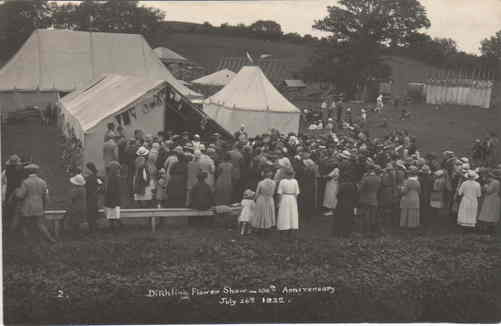
1922
This year saw the centenary celebration of the Flower Show which was celebrated in Star Field with Harris’s roundabouts and swing boats. Gertrude Waller's reminiscences from around the time, recall the children's excitement about the Horticultural Show which was always held on the last Wednesday in July and marked the end of the school year:
'We would rush home from school as fast as we could and have our dinner almost too excited to eat it. First there would a procession through the village. I can remember one of my grandmothers joining in with her black bonnet and black cape with ’80 not out’ on her poke bonnet. She marched up the High Street like a two year old ... The day before the show, we would go out and gather wild flowers and in the morning we would take them up ... we all hoped we would be the one that the judge picked out. 'We school children did a display of the Maypole ... In and out we would weave with all the pretty coloured ribbons, oh we were so proud ... There was always a lady with a tin bath full of confetti and you would get a big bag full for one penny'
1923
From the diary of Valentine KilBride we learn that the Horticultural Fair was held in July of this year and another Fair on September 19th, 1923 which he describes here: 'went up to the Fair field. Fancy dress was very prevalent. I saw the country dancing and heard the play and entertainment had been every good. It was a burlesque melodrama. About 9.0 or so the band left the field and led a procession round the village and up to Lodge Hill to the bonfire. It was quite dark then of course and everyone carried chinese lanterns on poles. The effect was most remarkable, quite carnivalesque'
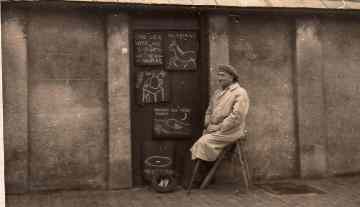
1949
Rev Arthur Crookshank, founder of the Village Association, again took an enthusiastic and humorous role in the Fair, setting himself up as a one legged street artist outside the Vicarage in West Street.
Next to his art he displayed the notice: ‘one leg, one wife, eight children, but I am giving all the receipts today to the Fair.
1953
This was Coronation year and the inauguration of the now famous Fair Proclamation exhorting people to come forth
‘spry and spracker from your Dymocks and your Jointure, your Bowries and your Boddingtons ...’
Since then the tongue-twisting proclamation, composed by the village GP Dr Linton-Bogle, has been read out by the Chairman of the Parish Council or more recently by the Vicar, every year.
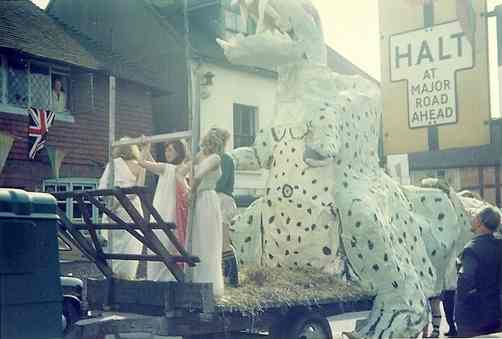
1964
Over the years, the procession of floats has tested villagers’ imaginations and ingenuity. One of the most memorable creations must be ‘Dennis the Ditchling Dinosaur’, the Rugby Club’s winning entry in 1964 - twenty feet tall and thirty-five feet from his nose to the tip of his tail, belching clouds of acrid smoke.
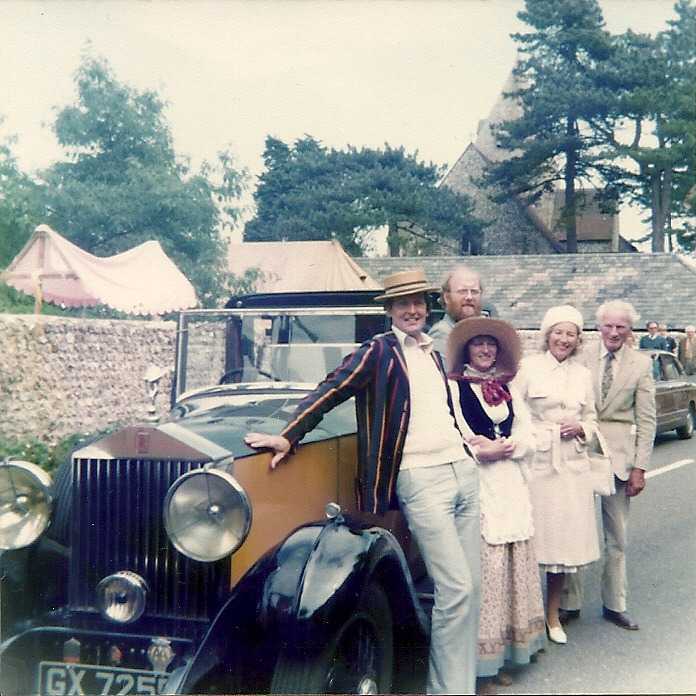
1982
From the diary of John Lord we have this account of the 1982 Fair in which he was one of the judges:
'The Fair Queen is duly crowned and this is followed by the judging of the various age groups’ Fancy Dress Competition. The judges include Vera Lynn, Gill Pryke and myself and we find it fairly easy to agree with each other in our selection of the prizes. Some of the best dresses were: a small sparrow, a parcel, a letter, and a teapot'
1994
Traditionally, the Fair Master would 'call' the fair and ring his bell early in the morning at sites around the village. In 1994, this role was taken over by Peter Luckin, as the Fair Wizard. Between the hours of 6.45 and 8.30 am he 'calls' at over 30 sites around the village in order to command that everyone assembles at nine o'clock ...
'to attend the ancient rites of Ditchling Village Fair; Hear the Grand Proclamation; watch in wonder the crowning of our gracious Fair Queen … Partake of luscious sweetmeats; see the mighty feats of men; delight in the music and dance; join in the games and festivities'
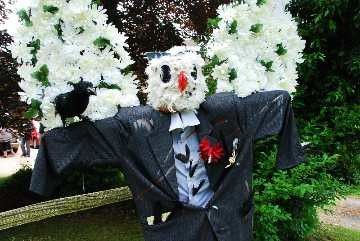
2004
Scarecrows first appeared around the village in the week before the Fair in 2004, each one promoting the theme for the year, each one unique and inventive in its construction.